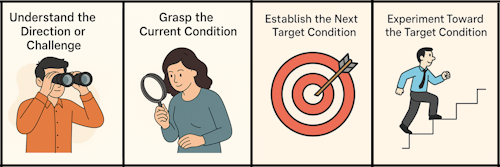Toyota Kata
Practice improvement routines to build a culture of learning.
"Measurement is the first step that leads to control and eventually to improvement."

Developed by Mike Rother based on practices observed in Toyota's production system, the Toyota Kata1 offers a structured routine for continuous improvement and coaching. Rather than focusing only on outcomes or tools, it centers on the way people think and behave when faced with challenges. By cultivating habits of scientific thinking and adaptive learning, Toyota Kata supports a culture of experimentation aligned with long-term goals. For Agile teams, this routine blends naturally with iterative delivery, helping them navigate uncertainty with deliberate practice and team-based inquiry.
Impact on Agile Teams
Toyota Kata transforms the way Agile teams think about improvement, not as a periodic activity but as a continuous daily routine. It operationalizes learning by embedding structured habits that promote clarity, focus, and resilience.
- Improvement Kata cultivates adaptive behavior:
- Clarifies a long-term vision or direction.
- Defines the next target condition to strive for.
- Reveals current obstacles through experimentation.
- Encourages small, data-informed steps to progress.
- Coaching Kata builds leadership capacity:
- Strengthens a leader's ability to guide without prescribing solutions.
- Reinforces feedback loops between learning and action.
- Promotes psychological safety through guided reflection.
- Aligns with Agile principles:
- Empowers decentralized decision-making.
- Increases team autonomy through problem-solving skills.
- Supports "inspect and adapt" by focusing on evidence over opinion.
Scenario
An Agile team at a large retailer has been struggling with a legacy deployment pipeline that often fails and delays releases. During Retrospectives, the team expresses frustration, but no meaningful change sticks.
The Scrum Master introduces Toyota Kata by helping the team define a target condition: "Build pipeline delivers feedback in under 10 minutes with zero false negatives." They map their current process, identify one key obstacle (e.g., flaky UI tests), and begin small experiments to address it. The Product Owner is coached to align backlog items to the target condition, and leaders begin asking Kata questions in one-on-ones and reviews.
Over several weeks:
- The team documents experiments, results, and insights.
- Communication with Ops improves through shared focus.
- Progress becomes visible and repeatable.
Eventually, the team achieves the target condition, and keeps going. The routine becomes part of how they think and act.
Ways to Mitigate Misuse or Misunderstanding:
To prevent Toyota Kata from becoming just another "Agile tool" rather than a way of thinking, Agile leaders should reinforce its foundational intent and create the right enabling environment:
- Cultural Alignment:
- Make learning a visible priority across all levels.
- Normalize failure as part of experimentation.
- Coaching Support:
- Train Scrum Masters and managers in Coaching Kata.
- Pair coaches with teams during early adoption.
- Practice Routines Consistently:
- Encourage teams to journal experiments and review learnings weekly.
- Use Kata questions in Daily Scrums, Retrospectives, and Reviews.
- Organizational Support:
- Tie team target conditions to broader strategic objectives.
- Recognize and reward curiosity, not just success.
The 5 Kata Questions
A hallmark of Toyota Kata practice is the consistent use of five coaching questions that help teams reflect, focus, and act with clarity. These questions are typically asked by a coach, Scrum Master, or team lead during check-ins or daily improvement conversations:
- What is the target condition?:
- What is the actual condition now?:
- What obstacles do you think are preventing you from reaching the target condition?:
- What is your next step (experiment)? What do you expect?:
- When can we go and see what we have learned from taking that step?:
Clarifies what we are working toward, not just the long-term vision but the immediate next state we aim to reach.
Creates a shared understanding of current reality, using observable facts rather than assumptions.
Surfaces potential blockers, both known and unknown, encouraging critical thinking and prioritization.
Promotes structured, hypothesis-driven action and small-scale experimentation.
Reinforces learning and accountability by creating a regular cadence of reflection.
Used regularly, these questions train the team to think scientifically, identifying gaps, running experiments, and adapting based on evidence rather than guesswork or assumptions.
Conclusion:
Toyota Kata is not a framework to implement but a mindset to cultivate. Its routines deepen Agile thinking by shifting focus from output to deliberate capability-building. Instead of relying on "hero" problem solvers or episodic Retrospectives, teams evolve together through structured experimentation. Leaders become coaches who unlock potential, rather than fixers who dictate solutions. This makes Toyota Kata a powerful enabler of sustainable agility and resilient cultures, especially in complex and evolving environments.
Key Takeaways
- Toyota Kata builds improvement and coaching habits into daily team work.
- It aligns with Agile values like experimentation, adaptation, and collaboration.
- Teams define target conditions and iterate toward them through small experiments.
- Coaching Kata helps leaders develop people rather than prescribe answers.
- Consistency and culture are critical for lasting impact.
Summary
Toyota Kata reinforces agility by embedding structured learning into the fabric of team dynamics. Through its Improvement and Coaching routines, it helps teams become more deliberate, adaptive, and resilient. For Agile organizations, it bridges the gap between intention and execution—not by introducing more process, but by developing better thinking habits.